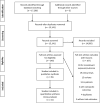Dietary Antioxidants, Circulating Antioxidant Concentrations, Total Antioxidant Capacity, and Risk of All-Cause Mortality: A Systematic Review and Dose-Response Meta-Analysis of Prospective Observational Studies
- PMID: 30239557
- PMCID: PMC6247336
- DOI: 10.1093/advances/nmy040
Dietary Antioxidants, Circulating Antioxidant Concentrations, Total Antioxidant Capacity, and Risk of All-Cause Mortality: A Systematic Review and Dose-Response Meta-Analysis of Prospective Observational Studies
Abstract
The associations of various dietary or circulating antioxidants with the risk of all-cause mortality in the general population have not been established yet. A systematic search was performed in PubMed and Scopus, from their inception up to October 2017. Prospective observational studies reporting risk estimates of all-cause mortality in relation to dietary intake and/or circulating concentrations of antioxidants were included. Random-effects meta-analyses were conducted. Forty-one prospective observational studies (total n = 507,251) involving 73,965 cases of all-cause mortality were included. The RRs of all-cause mortality for the highest compared with the lowest category of circulating antioxidant concentrations were as follows: total carotenes, 0.60 (95% CI: 0.46, 0.74); vitamin C, 0.61 (95% CI: 0.53, 0.69); selenium, 0.62 (95% CI: 0.45, 0.79); β-carotene, 0.63 (95% CI: 0.57, 0.70); α-carotene, 0.68 (95% CI: 0.58, 0.78); total carotenoids, 0.68 (95% CI: 0.56, 0.80); lycopene, 0.75 (95% CI: 0.54, 0.97); and α-tocopherol, 0.84 (95% CI: 0.77, 0.91). The RRs for dietary intakes were: total carotenoids, 0.76 (95% CI: 0.66, 0.85); total antioxidant capacity, 0.77 (95% CI: 0.73, 0.81); selenium, 0.79 (95% CI: 0.73, 0.85); α-carotene, 0.79 (95% CI: 0.63, 0.94); β-carotene, 0.82 (95% CI: 0.77, 0.86); vitamin C, 0.88 (95% CI: 0.83, 0.94); and total carotenes, 0.89 (95% CI: 0.81, 0.97). A nonsignificant inverse association was found for dietary zinc, zeaxanthin, lutein, and vitamin E. The nonlinear dose-response meta-analyses demonstrated a linear inverse association in the analyses of dietary β-carotene and total antioxidant capacity, as well as in the analyses of circulating α-carotene, β-carotene, selenium, vitamin C, and total carotenoids. The association appeared to be U-shaped in the analyses of serum lycopene and dietary vitamin C. The present study indicates that adherence to a diet with high antioxidant properties may reduce the risk of all-cause mortality. Our results confirm current recommendations that promote higher intake of antioxidant-rich foods such as fruit and vegetables.
Figures



Similar articles
-
Dietary and circulating vitamin C, vitamin E, β-carotene and risk of total cardiovascular mortality: a systematic review and dose-response meta-analysis of prospective observational studies.Public Health Nutr. 2019 Jul;22(10):1872-1887. doi: 10.1017/S1368980018003725. Epub 2019 Jan 11. Public Health Nutr. 2019. PMID: 30630552 Free PMC article.
-
Dietary Intake and Circulating Concentrations of Carotenoids and Risk of Type 2 Diabetes: A Dose-Response Meta-Analysis of Prospective Observational Studies.Adv Nutr. 2021 Oct 1;12(5):1723-1733. doi: 10.1093/advances/nmab048. Adv Nutr. 2021. PMID: 33979433 Free PMC article.
-
Dietary intake and blood concentrations of antioxidants and the risk of cardiovascular disease, total cancer, and all-cause mortality: a systematic review and dose-response meta-analysis of prospective studies.Am J Clin Nutr. 2018 Nov 1;108(5):1069-1091. doi: 10.1093/ajcn/nqy097. Am J Clin Nutr. 2018. PMID: 30475962 Free PMC article.
-
Carotenoid Intake and Circulating Carotenoids Are Inversely Associated with the Risk of Bladder Cancer: A Dose-Response Meta-analysis.Adv Nutr. 2020 May 1;11(3):630-643. doi: 10.1093/advances/nmz120. Adv Nutr. 2020. PMID: 31800007 Free PMC article.
-
Association between intake of antioxidants and pancreatic cancer risk: a meta-analysis.Int J Food Sci Nutr. 2016 Nov;67(7):744-53. doi: 10.1080/09637486.2016.1197892. Epub 2016 Jun 30. Int J Food Sci Nutr. 2016. PMID: 27356952 Review.
Cited by
-
A Narrative Review: The Effect and Importance of Carotenoids on Aging and Aging-Related Diseases.Int J Mol Sci. 2023 Oct 15;24(20):15199. doi: 10.3390/ijms242015199. Int J Mol Sci. 2023. PMID: 37894880 Free PMC article. Review.
-
Characterization, Conservation, and Breeding of Winter Squash (Cucurbita moschata Duchesne): Case Study of the Collection Maintained at the Federal University of Viçosa Vegetable Germplasm Bank.Plants (Basel). 2025 Jul 27;14(15):2317. doi: 10.3390/plants14152317. Plants (Basel). 2025. PMID: 40805666 Free PMC article. Review.
-
Fiber intake and risk of chronic obstructive pulmonary disease: A systematic review and dose response meta-analysis.Food Sci Nutr. 2023 Aug 23;11(11):6775-6788. doi: 10.1002/fsn3.3640. eCollection 2023 Nov. Food Sci Nutr. 2023. PMID: 37970426 Free PMC article. Review.
-
Halophilic Carotenoids and Breast Cancer: From Salt Marshes to Biomedicine.Mar Drugs. 2021 Oct 21;19(11):594. doi: 10.3390/md19110594. Mar Drugs. 2021. PMID: 34822465 Free PMC article. Review.
-
Evaluating Concordance of Bodies of Evidence from Randomized Controlled Trials, Dietary Intake, and Biomarkers of Intake in Cohort Studies: A Meta-Epidemiological Study.Adv Nutr. 2022 Feb 1;13(1):48-65. doi: 10.1093/advances/nmab095. Adv Nutr. 2022. PMID: 34308960 Free PMC article.
References
-
- Beaglehole R, Bonita R, Horton R, Adams C, Alleyne G, Asaria P, Baugh V, Bekedam H, Billo N, Casswell S. Priority actions for the non-communicable disease crisis. Lancet North Am Ed 2011;377(9775):1438–47. - PubMed
-
- World Health Organization. Global status report on noncommunicable diseases 2014. Geneva: WHO; 2014. - PubMed
-
- Sies H. Oxidative stress: oxidants and antioxidants. Exp Physiol 1997;82(2):291–5. - PubMed
-
- Siti HN, Kamisah Y, Kamsiah J. The role of oxidative stress, antioxidants and vascular inflammation in cardiovascular disease (a review). Vascul Pharmacol 2015;71:40–56. - PubMed
Publication types
MeSH terms
Substances
LinkOut - more resources
Full Text Sources
Other Literature Sources
Medical

